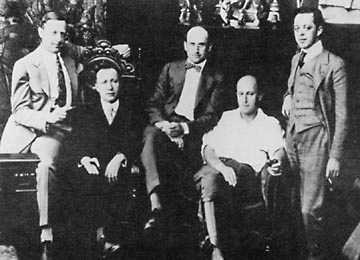| 1916 |
 Chronomedia index Chronomedia index
Numbers after entries link to the list of references. |
links and notes |
| February 26 |
Charlie Chaplin signs a contract for eight films with Mutual Film Corporation making him the world's highest paid performer at $675,000 a year. |
|
| March 16 |
Occupying German forces impose 10 per cent entertainment tax on cinemas and other forms of public entertainment. |
|
| • |
German government bans the importing and exhibition of all foreign films except Danish. [0036] |
> 1920 |
| • |
Entertainments Tax is imposed in the UK. |

UK Entertainments Tax |
| • |
In Australia a federal entertainments tax is introduced. [0036] |
> 1953 |
| June |
 Jesse L Lasky Feature Play Company and Famous Players Film Company merge as Famous Players Lasky Corporation. In the picture are (left to right) Jesse L Lasky, Adolph Zukor, Samuel Goldfish, Cecil B DeMille and Al Kaufman. Jesse L Lasky Feature Play Company and Famous Players Film Company merge as Famous Players Lasky Corporation. In the picture are (left to right) Jesse L Lasky, Adolph Zukor, Samuel Goldfish, Cecil B DeMille and Al Kaufman. |
> 1918 |
| autumn |
All film activity in Finland is banned ‘until further notice’ by the Russian ruling authorities. This lasts effectively until the March 1917 revolution in Russia and ends completely with the Finnish declaration of independence in December 1917. |
|
| September |
Vitagraph buys out its partners in VLSE, Lubin, Selig and Essanay. During the year, Vitagraph also acquires the Kalem production company. |
|
| October 27 |
Entertainment trade paper Variety [subsequently] claims a reference to 'jazz' in this issue is the first published use of the word. |
|
| November 19 |
Samuel Goldfish and Archibald Selwyn combine their surnames to form Goldwyn Picture Co—apocryphally after rejecting the alternative corresponding syllabic combination. (Think about it!) |
|
| November |
Lee de Forest broadcasts US presidential election results. (Woodrow Wilson wins a second term.) |
|
| December |
American Radio and Research Corporation broadcasting concerts two or three times a week. |
|
| • |
British import duty on blank film is 0.33d (0.14p) per linear foot; the rate for positive film prints is 1d (0.42p) a foot and for negative 5d (2.1p). |
|
| • |
Cinematograph-film Censor Act is passed by New Zealand's parliament, focusing in particular on war issues. |
|
| • |
Earliest known ‘twin’ cinema opens at 1540 Chene Street, Detroit—the Catherine Theatre. Designed by architect C Howard Crane and built 1913, it is enlarged to twin auditoria by architect George D Hurlburt. |
|
| • |
National Committee for Better Films is established in the US ‘to both liberate and formulate thought regarding motion pictures, their uses and possibilities, and the best way to achieve a free screen of the most desirable kind. |
|
| • |
Finland: 28 features and 312 short films made since 1904, plus one advertising film in each of the years 1914-1916. |
|
| • |
William Fox leases a studio in the Edendale suburb of Los Angeles, California. |
|
| • |
Society of Motion Picture Engineers (SMPE) is formed in the US. |
|
| • |
In the US, the German-born psychologist Hugo Münsterberg (1863-1917), a professor at Harvard University, conducts a pioneering study of the psychological effects on audiences of watching films, The Photoplay: A Psychological Study. |
|
| • |
The Début of Thomas Kat, first natural colour cartoon film (Brewster colour) is produced by the Bray Pictures Corporation of New York. |
|
| • |
Christiania Film Company is established in Norway. |
|
| • |
First feature length film made in Chile: La Baraja de la Muerte (The Deck of Death), directed by Salvador Giambastiane. |
|
| • |
In France, Lucien Lévy invents the superheterodyne system of radio transmission. |
> 1917 |
| • |
Western Electric develops the condenser microphone and the public address system. [0025] |
|
| • |
Max Aitken buys control of UK's Daily Express newspaper from receivership for £17,500. |
> 1917 |



















